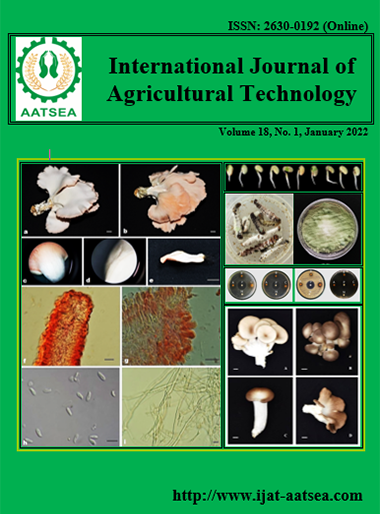The efficacy of Cinnamomum parthenoxylon roots as a biopesticide towards termite and wood-rotting fungi
Main Article Content
Abstract
The antitermite and antifungal activity of C. parthenoxylon roots constituents, namely n-hexane and methanol fractions against termite (Coptotermes curvignathus) and wood-rotting fungi (Trametes versicolor) was determined. The results showed that both fractions at 15% concentrations were reduced the survival of termite to 100% after 7 and 6 days of treatment. In addition, both fractions exhibited significant inhibition effects towards fungal growth compared to the control. The data showed that n-hexane fraction was more toxic than methanol fraction against T. versicolor. At 0.25% concentration, n-hexane and methanol fractions inhibited the fungal growth to 100% and 78.33%, respectively. The GC-MS profiling showed that most of the compounds detected from both fractions consisted of phenylpropanoid, aldehyde, fatty acids, long-chain hydrocarbons, sesquiterpenes, and lignans. The major component of n-hexane fraction were safrol (46.8%), octadecanal (14.35%), and elemicin (9.55%). While the main compounds of methanol fraction included 9,12-octadecadienoic acid, methyl ester (8.29%), safrole (7.98%), and octadecanoic acid, methyl ester (7.01%). The preliminary phytochemical test showed that n-hexane fraction contains terpenoids and coumarins, while the methanol fraction contains flavonoids, saponins, and tannins. Therefore, the presence of these compounds might be responsible for their antitermite and antifungal activities. It was observed that the antitermite potential of C. parthenoxylon was useful in controlling termite pests and wood-rotting fungi for now and near future.
Article Details

This work is licensed under a Creative Commons Attribution-NonCommercial-NoDerivatives 4.0 International License.
References
Adfa, M., Livandri, F., Meita, N. P., Manaf, S., Ninomiya, M., Gustian, I., Putranto, A. M. H., Supriati, R. and Koketsu, M. (2015). Termiticidal activity of Acorus calamus Linn. rhizomes and its main constituents against Coptotermes curvignathus Holmgren. Journal of Asia Pacific Entomology, 18:47-50.
Adfa, M., Romayasa, A., Kusnanda, A. J., Avidlyandi, A., Yudha, S.S., Banon, C. and Gustian, I. (2020). Chemical components, antitermite and antifungal activities of Cinnamomum parthenoxylon wood vinegar. Journal of the Korean Wood Science and Technology, 48: 107-116.
Adfa, M., Sanusi, A., Manaf, S., Gustian, I. and Banon, C. (2017). Antitermitic activity of Cinnamomum parthenoxylon leaves against Coptotermes curvignathus. Oriental Journal of Chemistry, 33:3063-3068.
Behtoei, H., Amini, J., Javadi, T. and Sadeghi, A. (2012). Composition and in vitro antifungal activity of Bunium persicum, Carum copticum and Cinnamomum zeylanicum essential oils. Journal of Medicinal Plants Research, 6:5069-5076.
Dũng, N. X., Mõi, L. D., Hung, N. D., and Leclercq, P. A. (1995). Constituents of the essential oils of Cinnamomum parthenoxylon (Jack) Nees from Vietnam. Journal of Essential Oil Research, 7:53-56.
Giraldo-Rivera, A. I. and Guerrero-Alvarez, G. E. (2019). Botanical biopesticides: research and development trends, a focus on the annonaceae family. Revista Colombiana de Ciencias Hortícolas, 13:371-383.
Guleria, S. and Kumar, A. (2006). Antifungal activity of some Himalayan medicinal plants using direct bioautography. Journal of Cell and Molecular Biology, 5:95-98.
Hani, A., Effendi, R. and Kosasih, A. S. (2010). Kisereh (Cinnamomum parthenoxylon (Jack) Meissn.), jenis pohon serbaguna dan potensial untuk hutan rakyat. Tekno Hutan Tanaman, 3:99-106 (In Indonesian).
Harborne, J. B. (1998). Phytochemical methods. A guide to modern techniques of plant analysis. 5th edition, Chapman and Hall, London, UK.
Huang, Y. and Ho, S. H. (1998). Toxicity and antifeedant activities of cinnamaldehyde against the grain storage insects, Tribolium castaneum (Herbst) and Sitophilus zeamais Motsch. Journal of Stored Products Research, 34:11-17.
Huang, Y., Ho, S. H. and Kini, R. M. (1999). Bioactivities of safrole and isosafrole on Sitophilus zeamais (Coleoptera: Curculionidae) and Tribolium castaneum (Coleoptera: Tenebrionidae). Journal of Economic Entomology, 92:676-683.
Morikawa, T., Ashitani, T., Kofujita, H. and Takahashi, K. (2014). Antitermitic activity of extracts from Chamaecyparis obtusa branch heartwood. European Journal of Wood and Wood Products, 72:651-657.
Ong, M., Chomistek, N., Dayment, H., Goerzen, W. and Baines, D. (2020). Insecticidal activity of plant powders against the parasitoid, Pteromalus venustus, and its host, the alfalfa leaf cutting bee. Insects, 1:1-20.
Pineda, R. M., Vizcaíno, S. P., García, C. M., Gil, J. H. and Durango, D. L. (2012). Chemical composition and antifungal activity of Piper auritum Kunth and Piper holtonii C. DC. against phytopathogenic fungi. Chilean Journal of Agricultural Research, 72:507-515.
Roszaini, K., Azah, M. N., Mailina, J., Zaini, S. and Faridz, Z. M. (2013). Toxicity and antitermite activity of the essential oils from Cinnamomum camphora, Cymbopogon nardus, Melaleuca cajuputi and Dipterocarpus sp. against Coptotermes curvignathus. Wood Science and Technology, 47:1273-1284.
Sekine, N., Ashitani, T., Murayama, T., Shibutani, S., Hattori, S. and Takahashi, K. (2009). Bioactivity of latifolin and its derivatives against termites and fungi. Journal of Agricultural and Food Chemistry, 57:5707-5712.
Tavares, A. C., Gonçalves, M. J., Cavaleiro, C., Cruz, M. T., Lopes, M. C., Canhoto, J. and Salgueiro, L. R. (2008). Essential oil of Daucus carota subsp. halophilus: composition, antifungal activity and cytotoxicity. Journal of Ethnopharmacology, 119:129-134.
Tisserand, R. and Young, R. (2013). Essential oil safety e‐book: a guide for health care professionals. Edinburgh, UK: Churchill Livingstone Elsevier.
Volpato, A., Baretta, D., Zortéa, T., Campigotto, G., Galli, G. M., Glombowsky, P., Santos, R. C. V, Quatrin, P. M., Ourique, A. F., Baldissera, M. D., Stefani, L. M., and Da Silva, A. S. (2016). Larvicidal and insecticidal effect of Cinnamomum zeylanicum oil (pure and nanostructured) against mealworm (Alphitobius diaperinus) and its possible environmental effects. Journal of Asia-Pacific Entomology, 19:1159-1165.
Wang, S. Y., Chen, P. F. and Chang, S. T. (2005). Antifungal activities of essential oils and their constituents from indigenous cinnamon (Cinnamomum osmophloeum) leaves against wood decay fungi. Bioresource Technology, 96:813-818.


